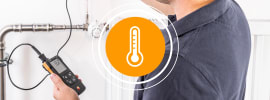Whether you are a technician servicing diesel engines, or a manufacturer who needs to provide proof of emission values – determining the smoke count is often part of your job. With the smoke tester testo 338, you are ideally equipped for the determination of the degree of blackening in diesel engines. The easy-to-operate, handy measuring instrument records the soot concentration (mg/m3) and the Filter Smoke Number (FSN) or Bosch number for you.
The smoke tester testo 338: flexibly applicable and suitable for industry
The smoke tester testo 338 provides the advantage that, as a portable instrument, it can be taken with you to the desired application site. Whether the diesel engines to be tested are in industrial plants, ships, shipyards or mines – with the testo 338, your smoke tester is always close at hand in your toolbox. This allows you to dispense with the complicated installation of stationary measurement systems.
Especially before commissioning or after servicing diesel engines, a measurement of the smoke count is recommended. This allows you to determine whether the injection is correctly adjusted or whether there are interior engine problems. However, for proof of emission values, it is also often necessary to determine the degree of blackening – for example in mining or shipping, in order to fulfil special environmental stipulations or for testing diesel particle filters. The manufacturers of diesel engines must also meet the requirements of their customers, and provide proof of this. With the testo 338, the first mobile smoke tester with direct data analysis, you are ideally equipped for these applications.
The tab "Applications" provides more information on the application of the testo 338 in the following areas:
- Commissioning and servicing diesel/industrial engines
- Diesel engine manufacturing
- Shipping companies and dockyards
- Mining and prospecting
- Construction machines and land-moving vehicles
Smoke counter with innovative technology and high user-friendliness
Start up, measure, understand – no action is superfluous. This is how easy smoke count measurement can be. And how fast. Because the compact testo 338 frees you from handpumps and complicated comparative tables. As the first portable smoke tester, it automatically displays the degree of blackening without needing to use complex analysis electronics.
Thanks to the easy operation of the testo 338, the measurement of degree of blackening is possible without extensive training. The smoke tester directly shows you optionally either the Filter Smoke Number (FSN) or the Bosch number. The instrument also gives the soot concentration. Apart from this, you can also create a connection via infrared interface to the optionally available Testo fast printer, and print out the measurement data easily on site.
What’s included
Smoke counter testo 338, including gas sampling probe, TopSafe, mains unit and instrument case.





























